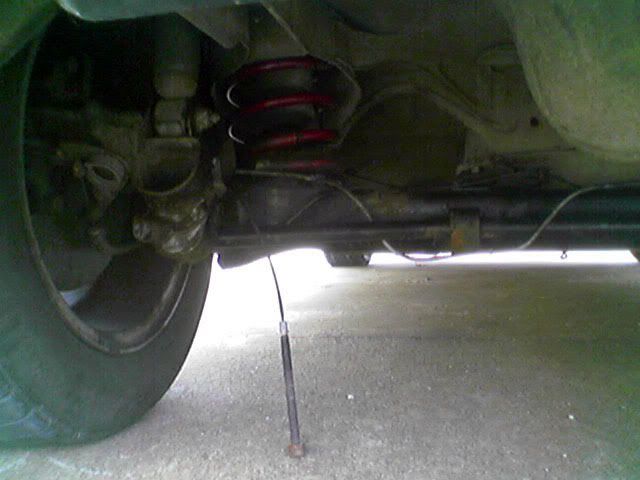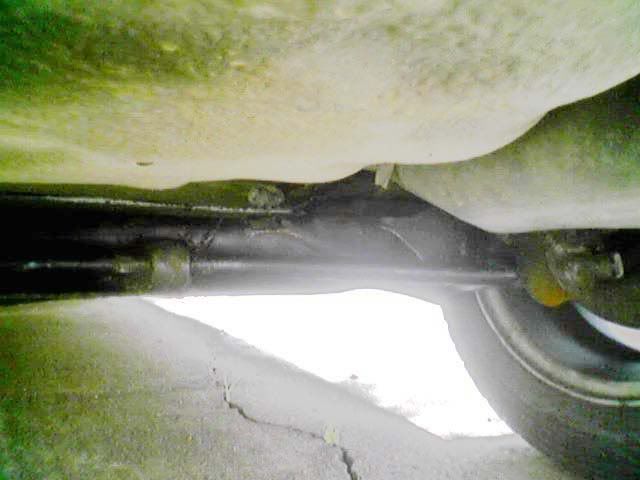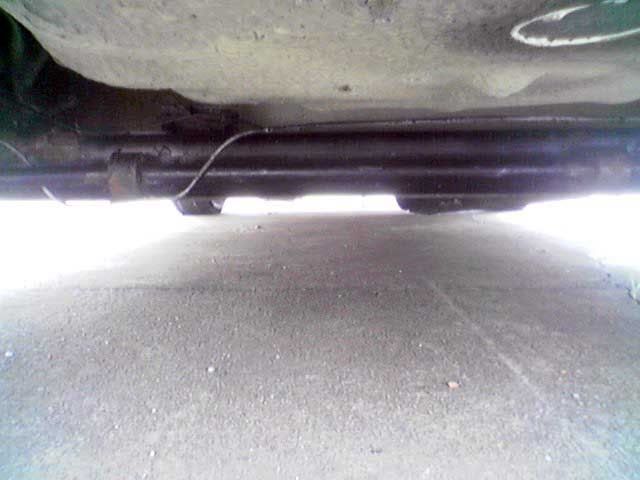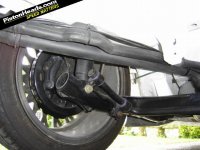You are using an out of date browser. It may not display this or other websites correctly.
You should upgrade or use an alternative browser.
You should upgrade or use an alternative browser.
Technical rear anti roll bar
- Thread starter Platoon
- Start date
Currently reading:
Technical rear anti roll bar
have you thought about fitting a bar manufactured to fit an uno?
have you thought about fitting a bar manufactured to fit an uno?
i misread this thread, had a strut brace in mind. Can you actually buy rear anti roll bars for the uno? wouldnt mind 1 myself.
check out Turbocollective and look at the hillclimb/track uno turbo 
Most people stiffen the rear beam of the Uno, since it has an anti-roll quality already (has the same geometry that an anti-roll bar does for other suspension types - links the two wheels together).
The easiest way to stiffen the beam is to weld a plate underneath. A more thorough way is to weld something inside the beam, such as a tube or rod.
-Alex
The easiest way to stiffen the beam is to weld a plate underneath. A more thorough way is to weld something inside the beam, such as a tube or rod.
-Alex
yeah I heard about that as well but it seems that then you start getting cracks all around the body and suspension mounts and all that!
You'll probably get the same if you fit an anti-roll bar to the rear from what I've read. I suspect that one problem of fitting an anti-roll bar is that they normally work best on independent suspension arrangements, which the Uno hasn't got at the rear. As Alex mentioned, the Uno has a beam type dead axle at the rear that already has some anti-roll bar type properties.
The beam is a torsion beam. Its designed to flex to mimic an independent design. As the beam flexes it "winds" up the torsion in the beam just like a torsion bar, this is where the ARB properties come from. In reality the torsion of the beam is weak as ****. A person can easily twist the beam to full deflection.
Stiffening the beam wont cause the body to crack but it may cause the beam to crack. It will place higher stress on other parts of the beam.
A custom fitted ARB is the better solution. It will leave the beam alone to operate as it was designed and the ARB can do what it is designed to do also.
Stiffening the beam wont cause the body to crack but it may cause the beam to crack. It will place higher stress on other parts of the beam.
A custom fitted ARB is the better solution. It will leave the beam alone to operate as it was designed and the ARB can do what it is designed to do also.
The beam is a torsion beam. Its designed to flex to mimic an independent design. As the beam flexes it "winds" up the torsion in the beam just like a torsion bar, this is where the ARB properties come from. In reality the torsion of the beam is weak as ****. A person can easily twist the beam to full deflection.
Stiffening the beam wont cause the body to crack but it may cause the beam to crack. It will place higher stress on other parts of the beam.
A custom fitted ARB is the better solution. It will leave the beam alone to operate as it was designed and the ARB can do what it is designed to do also.
That is all true, but there is nowhere near as much flexing in the beam axle trailing arms compared with the arms of an independent set up, which is why independent rear suspension set ups often have ARB's fitted and rear beam axles don't. The problem with fitting an ARB to a rear beam suspension is that roll bar is having to act against the beam torsion as well as the suspension spring tension, whereas with a fully independent rear suspension it would only be acting against the suspension spring tension.
Ages ago there was someone on here (an Australian I think?) who did manage to fit a rear anti-roll bar to a Uno but suffered from lots of metal fatigue/ cracking where the ends of the anti-roll bar were mounted (on the shell if I recall correctly).
I got this from Wiki regarding an ARB:
"Anti-roll bars provide two main functions. The first function is the reduction of body lean. The reduction of body lean is dependent on the total roll stiffness of the vehicle. Although Anti-roll bars reduce body lean, this comes at the expense of increased weight transfer at the end it is applied to. To keep the body level in cornering, the bar pulls up on the inside tire (therefore under loading it) and pushes on the outside wheel (over loading it). Anti-roll bars therefore reduce overall grip at the end they are installed to".
[ame]http://en.wikipedia.org/wiki/Anti_roll_bar[/ame]
Maybe it's not such a good idea to add an ARB to the rear after all if it loses grip, and maybe that's why Fiat didn't fit one originally? :chin:
Ages ago there was someone on here (an Australian I think?) who did manage to fit a rear anti-roll bar to a Uno but suffered from lots of metal fatigue/ cracking where the ends of the anti-roll bar were mounted (on the shell if I recall correctly).
Aha, it was actually you SteveNZ who posted a thread on this subject!
http://www.turbo124.com/forum/viewtopic.php?t=3669
It came from this thread covering the rear anti roll bar:
https://www.fiatforum.com/uno/93865-my-uno-project-rear-anti-roll-bar.html
great stuff mate! I'll try to find a golf gti mk1 ARB and attached it to the rear beam...what I wanted was to just reinforce the beam, what I see from the links (especially the one with the white uno) is that he's attaching the bar to the body , I don't really get what advantages can he be getting by doing so.
EssexUno
Member
- Joined
- Jan 20, 2009
- Messages
- 233
- Points
- 50
yea i noticed that lol, he had the inner (middle) part of the anti-roll bar on the rear beab, which is good and then he attached both the ends of the anti-roll bar to the body 
I'm pretty sure it would have a minor effect as the middle of the anti-roll bar would hole a little tension but it would be more effective if the ends were attached to the rear beam as well.
Dan
I'm pretty sure it would have a minor effect as the middle of the anti-roll bar would hole a little tension but it would be more effective if the ends were attached to the rear beam as well.
Dan
Ev0luti0n_FX
New member
- Joined
- Mar 19, 2007
- Messages
- 25
- Points
- 5
hello!
I haven't read the whole topic but i saw people talking on the GOLF MK1 ARB. It is almost a direct fit. Only need you need to do is get proper bushes. I got one for my axle 2 years ago, and installed it. Never tested on the road though.
Here are the pics..



Wasn't properly installed though, but i think you can get an idea!

And going offtopic but: what about a frontal lower strut bar? have searched everywhere, with no success!
I haven't read the whole topic but i saw people talking on the GOLF MK1 ARB. It is almost a direct fit. Only need you need to do is get proper bushes. I got one for my axle 2 years ago, and installed it. Never tested on the road though.
Here are the pics..



Wasn't properly installed though, but i think you can get an idea!
And going offtopic but: what about a frontal lower strut bar? have searched everywhere, with no success!
Last edited:
randomspeedfreak
New member
This man is correct based on what i knowThe beam is a torsion beam. Its designed to flex to mimic an independent design. As the beam flexes it "winds" up the torsion in the beam just like a torsion bar, this is where the ARB properties come from. In reality the torsion of the beam is weak as ****. A person can easily twist the beam to full deflection.
Stiffening the beam wont cause the body to crack but it may cause the beam to crack. It will place higher stress on other parts of the beam.
A custom fitted ARB is the better solution. It will leave the beam alone to operate as it was designed and the ARB can do what it is designed to do also.
That is all true, but there is nowhere near as much flexing in the beam axle trailing arms compared with the arms of an independent set up, which is why independent rear suspension set ups often have ARB's fitted and rear beam axles don't. The problem with fitting an ARB to a rear beam suspension is that roll bar is having to act against the beam torsion as well as the suspension spring tension, whereas with a fully independent rear suspension it would only be acting against the suspension spring tension.
Ages ago there was someone on here (an Australian I think?) who did manage to fit a rear anti-roll bar to a Uno but suffered from lots of metal fatigue/ cracking where the ends of the anti-roll bar were mounted (on the shell if I recall correctly).
I got this from Wiki regarding an ARB:
"Anti-roll bars provide two main functions. The first function is the reduction of body lean. The reduction of body lean is dependent on the total roll stiffness of the vehicle. Although Anti-roll bars reduce body lean, this comes at the expense of increased weight transfer at the end it is applied to. To keep the body level in cornering, the bar pulls up on the inside tire (therefore under loading it) and pushes on the outside wheel (over loading it). Anti-roll bars therefore reduce overall grip at the end they are installed to".
http://en.wikipedia.org/wiki/Anti_roll_bar
Maybe it's not such a good idea to add an ARB to the rear after all if it loses grip, and maybe that's why Fiat didn't fit one originally? :chin:
correct, anti roll bars do usually reduce grip on the end they are applied to.
However, as with everything to do with car set up its not that simple. We are not actually installing the anti roll bar to work as an anti roll bar at all.
Arb's have to be attached to the chassis in order to actually function as an arb (using the leverage of the 'loaded' side of the car to push against the 'unloaded' sides suspension, therefore 'flattening' the car as it corneres).
All the arb is doing in the case of the uno is stregntening the rear beam.
as previously mentioned the tortion beam loads up and twists as force is applied.
The reason that the arb is percived to improve rear end stabillity, is becasue the stronger rear beam drives the unloaded tyre into the road harder.
This sacrifices of the maximum grip of the loaded tyre, and transferrs more of the force that is pushing it into the road, to the other side of the car).
This means that : before the arb was fitted, the loaded rear tyre was providing nearly all the rear end grip through the corner, as it was being driven hard into the ground (it didnt have to 'share' the force with the unloaded side, beacuse the beam connecting them is too flexible).
The result of this is one side of the car is providing most of the grip of the rear end - if this grip is lost then thats it
Because this tyre is very close to its adhesion limit it means that this is all too easy to do.
Fitting a stronger or modified rear beam (in this case an 'arb') means that the unloaded side of the rear axle is driven into the road harder.
This takes away some of the force applied to the outside wheel, and shares it with the inside, so ultimate grip may be lower, however, you now have the inside rear wheel gripping (a bit), you have two points of contact on the road, both of which have some tolerance before they reach their adhesion limit, and when they do reach this limit, it isnt as bigger deal as before - the torsion beam requires less 'flex' to load up, it will do it faster, and at a higher road speed, therefore rear grip can be regained more quickly.
thank you all so much for the info! at the end I bought a rear arb from a fiesta rs turbo mk2, it should be a straight fit, I'll try it and let u know, we may have a huge improvement for a fer pounds!!!
Will be interested to see the results
What type of suspension does the Fiesta RST have? Independent or beam axle? Do you have any pictures of the RST rear suspension with roll bar fitted?
Is the Fiesta ARB only connected to the rear axle at two point on each side of the axle and not in the middle of the axle.
Unclechuchu
Member
There is a lot of opinions about anti roll bars. I'm currently in the beginning of building a race car (Uno), and I'm not going to use ARB in the front. I'm compensating for that with stiff springs (starting with 500lbs on front, 600lbs on rear, they are cheap to change). I have plans for stiffening the rear axle of some sort, either with an ARB, or just stiffening the axle. This will help getting lift on the inner rear wheel during turns, which means that there's only 3 wheels left to split the weight. An ARB in the front will cause the front inner wheel to lift off, and start spinning. This setup will probably be quite nervous in high speed corners, but work well in low speed corners.
-Vegard
-Vegard
Similar threads
- Replies
- 9
- Views
- 636



